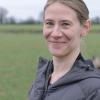Allen, et al (2011) defined mob stocking is ‘a method of stocking at a high grazing pressure for a short time to remove forage rapidly as a management strategy’.
These descriptions of grazing systems which focus on long rest periods, high grass cover and high stocking density have been around for many years. Many of the principles of what is now referred to as mob grazing are included in ‘The Savory Grazing Method’ (Savory & Parsons, 1980), which was developed to conserve the rangelands of Zimbabwe. This method of grazing management recommends concentrating animals into large herds and introducing them to small paddocks to graze for a short period of time (1-5 days) during the growing season. This allows trampling of vegetation and additions of dung and urine to the soil over a small area. Rest periods of between 30 and 60 days are suggested to allow the vegetation to recover.
However, there is no formal agreed definition of mob grazing which includes values for stocking density, frequency of livestock movements, or the length of the rest period after grazing, and there were substantial differences in grazing systems described as ‘mob grazing’ in the literature. This lack of formal definition is also seen in surveys with farmers. Gurda, et al., (2018) surveyed 155 farmers in mid-western USA to derive a farmer’s definition of mob grazing. The authors suggested that it was difficult to come up with a clear definition although the practice typically involved high stocking density, long rest periods and short grazing intervals. A recent survey of UK farmers as part of an ongoing Defra project showed that many farmers used multiple grazing terms to describe similar grazing systems, and ‘Mob grazing’ was used interchangeably with ‘cell grazing’, ‘high stocking density grazing’, ‘holistic grazing’, ‘long grass grazing’, ‘non-selective grazing’, ‘rotational grazing’ and ‘management intensive grazing’.
Mob grazing systems have been reported to have many benefits including increasing sward productivity, reducing the need for fertiliser inputs, increasing soil organic matter, and enhancing biodiversity. Possible negative impacts associated with mob grazing include reduced sward digestibility, increased risk of soil damage especially where high density grazing occurs on wet soils and the potential for a higher burden of insect vectors breeding in long swards leading to increased livestock health issues. However, there is very limited UK research which has quantified the impact of mob grazing systems, and most UK farmers adopting the system have been influenced by anecdotal evidence from other farmers and/or have drawn from experiences and research from overseas where soil and climatic conditions may be very different to the UK.
To address this evidence gap, Defra have commissioned an ADAS led consortium to look at the environmental and productivity benefits of mob grazing systems in the UK. The project is comparing mob grazing and conventional grazing systems at multiple farm sites across the country. Measurements include livestock performance, soil quality, biodiversity, and diffuse pollution (nitrate leaching, ammonia and nitrous oxide emissions). The project runs from 2021 to 2026.
References
Allen, V. G., Batello, C., Berretta, E.J., Hodgson, J., Kothmann, M., Li, X., McIvor, J., Milne J., Morris, C., Peeters, A., & Sanderson, M. 2011. An international terminology for grazing lands and grazing animals. Grass and Forage Science, 66(1), pp. 2 - 28.
Gurda, A.M., Renz, M.J. & Brink, G. 2018. Defining mob grazing in the upper midwestern United States. Journal of Extension, 56(4).
Savory, A. & Parsons, S.D. 1980. The Savory grazing method. Rangelands. 2(6), pp. 234-237.


